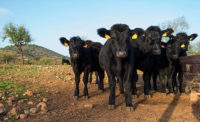It’s been close to a year since the National Cattlemen’s Beef Association (NCBA), a contractor to the Beef Checkoff, relaunched the “Beef. It’s What’s For Dinner.” brand and a new Web site serving as one comprehensive location for all things beef. Since BeefItsWhatsForDinner.com launched, it has attracted more than 8 million views. These metrics demonstrate consumer interest in learning more about beef and where it comes from. This is good news as the cattle herd grows.
This growth in the global and domestic beef cattle herd also means supply is on the upswing and the beef industry is gaining momentum through cattle prices. Coupled with the reemergence of the iconic “Beef. It’s What’s For Dinner.” brand, these industry indicators are reason for continued optimism.
ANNUAL BEEF FORECASTS
| 2015 | 2016 | 2017 | 2018 | 2019 | |
|---|---|---|---|---|---|
| Production (million lb.) | 23,698 | 25,221 | 26,187 | 27,094 | 27,720 |
| Per capita disappearance (retail lb.)* | 54.0 | 55.5 | 56.9 | 57.7 | 58.7 |
| Beef and veal exports (million lb.) | 2,267 | 2,557 | 2,860 | 3,124 | 3,205 |
| Beef and veal imports (million lb.) | 3,368 | 3,012 | 2,993 | 3,037 | 3,140 |
Forecasts are in bold. * Per capita meat disappearance data are calculated using the Resident Population Plus Armed Forces Overseas series from the Census Bureau of the Department of Commerce. All data as of Aug. 14, 2018. Source: World Agricultural Supply and Demand Estimates and Supporting Materials. For further information, contact: Mildred M. Haley, mhaley@ers.usda.gov
Additionally, since 2015, severe drought conditions have subsided and increased beef production will likely continue through the end of the decade. Although the beef supply has been increasing, beef prices have also remained strong thanks to a high demand for beef.
Given a turnaround in per capita consumption is in the forecast, it is important to look at where the country stands economically to more fully understand how consumers might respond to increased availability of beef. Put simply, the continued rise in consumer confidence in the economy should foster an environment that could facilitate stronger beef sales moving forward, according to the University of Michigan’s 2017 Surveys of Consumers.
Data coming out of the retail channel is also encouraging. Retail accounts for just less than half of all beef pounds sold, and summer 2018 has been particularly strong for retailers featuring beef. This can likely be explained by findings of checkoff-funded research that showed when consumers purchase beef at the grocery store they tend to add other items to their cart they might not otherwise select. This increases overall sales for retailers.
The value story is similar for the foodservice channel. When a consumer orders a steak meal at a restaurant, the total bill tends to be greater as consumers are more likely to also order an appetizer, side, beverage or desert, according to the 2017 Checkoff Foodservice Insights Report.
While the retail and foodservice channels are where most of domestic beef is purchased, we also know, given the heavy adoption of digital technology and social media services, consumers are continually seeking more and better ways to find information about the food they eat online. This is especially true for Millennials, who represent a considerable opportunity for beef, given their numbers and spending potential. To ensure beef is a part of this technological revolution, NCBA, a contractor to the Beef Checkoff, is engaging with online food delivery services such as Amazon Fresh to make sure the information provided about beef is accurate and connects with the online shopper. The checkoff also connects with national and regional traditional brick and mortar retailers, sharing checkoff-funded research and insights that prove useful as these establishments evolve their business models with digital and online extensions.
JERKY: TOP 10 RETAIL BRANDS
| Brand | Dollar Sales | Dollar Sales % Chg YAgo | Unit Sales | Unit Sales % Chg YAgo |
|---|---|---|---|---|
| Jack Link's | $452,205,920 | 3.88 | 80,863,704 | 2.67 |
| Private Label | $117,749,496 | 12.96 | 21,375,892 | 7.85 |
| Bridgford Sweet Baby Ray's | $90,781,904 | 21.66 | 19,733,670 | 13.80 |
| Old Trapper | $50,126,008 | 35.47 | 4,368,801 | 32.88 |
| Krave | $38,761,512 | (17.55) | 7,845,213 | (15.38) |
| Oberto | $25,647,398 | (27.18) | 5,113,277 | (29.51) |
| Lorissa's Kitchen | $13,994,612 | 2.54 | 2,630,160 | (0.78) |
| Matador by Jack Link's | $11,957,936 | (33.08) | 2,290,811 | (31.55) |
| Perky Jerky | $11,167,331 | (7.45) | 2,605,389 | (9.85) |
| Tillamook Country Smoker | $10,765,548 | 45.29 | 1,428,304 | 22.95 |
| Total Jerky Category | $917,742,400 | 2.56 | 166,467,184 | (0.93) |
| Total Dried Meat Snacks Category | $1,505,652,224 | 5.43 | 414,685,472 | 3.20 |
Source: Infoscan Reviews, IRI, a Chicago-based market research firm (@iriworldwide). Total US Multi-Outlet (Grocery, Drug, Mass Market, Military and Select Club & Dollar Retailers), latest 52 weeks ending Aug. 12, 2018.
Note: Rankings of top brands are NOT totaled brand listings (e.g. all UPCs or brand extensions rolled up into a single figure, such as Total Crest Toothpaste), but are rather individual brand listings.
OTHER DRIED MEAT SNACKS: TOP 10 RETAIL BRANDS
| Brand | Dollar Sales | Dollar Sales % Chg YAgo | Unit Sales | Unit Sales % Chg YAgo |
|---|---|---|---|---|
| Slim Jim | $252,784,416 | 5.35 | 116,554,080 | 2.47 |
| Jack Link's | $119,713,840 | 9.39 | 42,635,884 | 2.28 |
| Old Wisconsin | $36,850,796 | 10.04 | 6,921,817 | (1.54) |
| Duke's | $18,995,000 | 31.57 | 3,937,245 | 25.30 |
| Private Label | $14,213,091 | 41.49 | 5,209,314 | 30.98 |
| Old Wisconsin Turkey Bites | $12,863,728 | 1.76 | 4,256,248 | 2.05 |
| Penrose Big Mama | $9,181,802 | 8.80 | 6,182,915 | 4.86 |
| Tillamook Country Smoker | $8,889,141 | 17.87 | 5,385,463 | 12.99 |
| Matador by Jack Link's | $8,417,139 | 10.98 | 7,472,385 | 10.34 |
| Jack Link's All American | $8,075,365 | 64.54 | 6,782,693 | 46.17 |
| Total All Other Meat Snacks | $587,909,760 | 10.25 | 248,218,272 | 6.17 |
Source: Infoscan Reviews, IRI, a Chicago-based market research firm (@iriworldwide). Total US Multi-Outlet (Grocery, Drug, Mass Market, Military and Select Club & Dollar Retailers), latest 52 weeks ending Aug. 12, 2018.
Note: Rankings of top brands are NOT totaled brand listings (e.g. all UPCs or brand extensions rolled up into a single figure, such as Total Crest Toothpaste), but are rather individual brand listings.
The Cattlemen’s Stewardship Review
The beef industry also sees positive momentum when it comes to producer sentiment around key production- and community-related topics and issues. These producer commitments to animal welfare, beef quality, sustainability and community involvement are detailed in the Cattlemen’s Stewardship Review (CSR) report, which was released earlier this year by the National Cattlemen’s Beef Association, a contractor to the Beef Checkoff. The report, the second of its kind, shows improvements have been made across the cattle industry, resulting in more responsibly raised beef. In addition, the report includes a comprehensive profile of the beef community today, the impact of beef production on the U.S. economy and the research-based tools and resources used to raise beef.
Report highlights include:
• Healthier animals: Animal care is at the heart of everything the beef community does. According to survey results, the well-being of cattle is priority one for 95 percent of producers, according to the Aspen Media’s 2017 Producer Profile Study. From pasture to feedyard, the beef industry has worked with experts — including world-renowned animal behaviorist Temple Grandin, Ph.D. — to improve the well-being of every animal.
• Better beef: Cattle producers strive to produce the best beef possible and do so by implementing research-based improvements across three areas: nutritional value, beef quality and safety assurance. Since the 1920s, America’s farmers and ranchers have supported nutrition research to better understand beef’s role in a balanced, healthy lifestyle. Today’s lean beef delivers both essential nutrients and great taste. The quality of beef, from taste to tenderness, ensures consumers get the maximum benefit and enjoyment from beef each time they cook it at home or order it in a restaurant. In addition to improvement in beef’s nutrition and tenderness, the safety of the beef supply continues to be a focus for all members of the beef community. As reported in the CSR report, 97 percent of cattle farmers and ranchers believe that producing safe beef is crucial to the future of the industry.
• Smarter resource use: America’s cattle farmers and ranchers revere the land and resources entrusted to them, and do not take their responsibility to preserve them lightly. As part of the CSR report, 95 percent of producers reported land conservation is extremely important to them, and 86 percent manage their operations in a way that protects the quality of natural resources, including wildlife and biodiversity. Every food has a footprint, including beef, and producers are mindful of resource consumption and environmental impact.
• Stronger communities: Beef is produced in all 50 states by a diverse group of men and women. They have different backgrounds, different production methods and are different ages, but a set of core values seems to unite much of this impressive community. Specifically, 91 percent of cattle operations are family owned, so it’s no surprise that cattle farmers and ranchers are focused on family and future generations, as shown in USDA and Census surveys. There are many ways cattle producers contribute to their local communities. Nearly half are involved with a youth organization, more than a third donate their time to civic organizations and about 20 percent have served in the military. NP






Report Abusive Comment